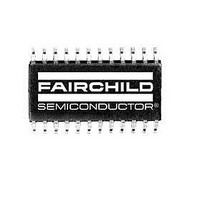ML6429CS Fairchild Semiconductor, ML6429CS Datasheet - Page 7

ML6429CS
Manufacturer Part Number
ML6429CS
Description
Video ICs Cable Driver/Filter 75Ohm Quad Video
Manufacturer
Fairchild Semiconductor
Type
Provide DC coupled outputs for certain applicationsr
Datasheet
1.ML6429CS.pdf
(14 pages)
Specifications of ML6429CS
Operating Supply Voltage
5 V
Maximum Operating Temperature
70 C
Package / Case
SOIC-24
Minimum Operating Temperature
0 C
Mounting Style
SMD/SMT
Lead Free Status / RoHS Status
Lead free / RoHS Compliant
Available stocks
Company
Part Number
Manufacturer
Quantity
Price
Company:
Part Number:
ML6429CS
Manufacturer:
APNEL
Quantity:
852
Part Number:
ML6429CS
Manufacturer:
FAIRCHILD/仙童
Quantity:
20 000
PRODUCT SPECIFICATION
Typical Applications
Basic Applications
The ML6429 provides channels for two banks of inputs for
RGB and composite video. The R and G channels can be
used as luma inputs while the B channel can be used as a
chroma input. Composite outputs and an H-sync output is
also provided. There are several configurations available
with the ML6429. Figure 4 includes a list of basic output
options for composite, S-video, TV modulator, and RGB
outputs. Note that each composite channel can drive a CV
load or a channel modulator simultaneously. The ML6429
standalone can be used as an EVC or SCART cable driver
with nine video sources (75Ω or low impedance buffer) and
seven video outputs. All inputs and outputs are AC coupled.
When driving seven loads, power dissipation must be
measured to ensure that the junction temperature doesn’t
exceed 120ºC.
EVC Cable Driving
The ML6429 can be configured to drive composite video,
S-video, and horizontal sync through an EVC connector
(Figure 5). Composite video and S-video inputs are filtered
through 4th-order Butterworth filters and driven through
internal 75Ω cable drivers. A buffered H-sync output is also
available.
SCART Cable Driving
The ML6429 can be configured either as a SCART cable
driver (Figure 4) or as a SCART cable driver and S-video
driver (Figure 6). A horizontal sync output is also available.
Note that the ML6429 can be used in a master-slave mode
where the sync-out from the master is used as the sync-in of
the slave; this allows the CV, S-video, and RGB channels to
operate under the same sync signals.
Note that in SCART applications, it is not always necessary
to AC couple the outputs. Systems using SCART connectors
for RGB and composite video can typically handle between
0 and 2V DC offset (see DC Coupled Applications section).
RGB Applications
RGB video can be filtered and driven through the ML6429.
For sync suppressed RGB, the sync signal can be derived
from SYNCIN PIN.
OSD (On-Screen Display) Applications
Unfiltered RGB video from an OSD processor needs to be
filtered and then synchronized to a fast blanking interval or
alpha-key signal for later video processing. With the total fil-
ter delay being 80ns ±10ns, a D flip-flop or similar delay ele-
ment can be used to delay the fast blanking interval or alpha-
key signal, which synchronizes the RGB and OSD signals
(Figure 9).
REV. 1.0.0 8/28/03
Channel Multiplexing
The ML6429 can be configured for multiple composite chan-
nel multiplexing (Figure 8). Composite and RGB sources
such as VCRs, and digital MPEG 2 sources can be selected
using the ML6429 swap mux controls. A/B MUX, SWAP
CVU, and SWAP CVF signals can be used to select and
route from various input sources.
DC Coupled Applications
The 220µF capacitor coupled with the 150Ω termination
forms a highpass filter which blocks the DC while passing
the video frequencies and avoiding tilt. Lower values such as
10µF would create a problem. By AC coupling, the average
DC level is zero. Thus, the output voltages of all channels
will be centered around zero.
Alternately, DC coupling the output of the ML6429 is
allowable. There are several tradeoffs: The average DC level
on the outputs will be 2V; Each output will dissipate an
additional 40mW nominally; The application will need to
accommodate a 1V DC offset sync tip; And it is recom-
mended to limit one 75Ω load per output. However, if two
loads are required to be driven at a time on the composite
output while DC coupling is used, then the swap–mux and
5th line driver can be configured to enable the filtered
composite signal on both the 4th and 5th line drivers.
Thus, the composite load driving requirement is divided into
two line drivers versus one.
Required Setup: A composite or luma or green signal must
be present on CV
necessary sync signals to other channels (R,G,B,Y,C). Other-
wise, sync must be provided at the SYNCIN pin. For RGB
applications, the green channel with sync can be used as an
input to CV
Using the ML6429 for PAL Applications
The ML6429 can be optimized for PAL video by adding
frequency peaking to the composite and S-video outputs.
Figure 10 illustrates the use of an additional external capaci-
tor (300pF), added in parallel to the output source termina-
tion resistor. This raises the frequency response from 1.0dB
down at 4.8MHz (for no peaking cap) to 0.2dB down at
4.8MHz (for 300 pF), which allows for accurate reproduc-
tion of the upper sideband of the PAL subcarrier. Figure 11
shows the frequency response of PAL video with various val-
ues of peaking capacitors (0pF, 220pF, 270pF, 300pF)
between 0 and 10MHz.
For NTSC applications without the peaking capacitor, the
rejection at 27MHz is 40dB (typical). For PAL applications
with the peaking capacitor, the rejection at 27MHz is 34dB
(typical). (Figure 12). The differential group delay is shown
in Figure 13 with and without a peaking capacitor (0pF,
220pF, 270pF, and 300pF) varies slightly with capacitance;
from 8ns to 13ns.
INU
A/Y2 or CV
INU
A/Y2 or CV
INU
B/Y3.
INU
B/Y3 inputs to provide
ML6429
7












